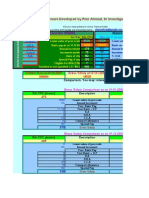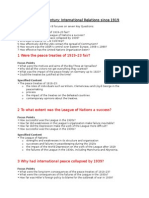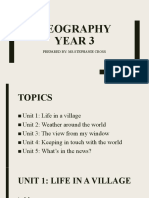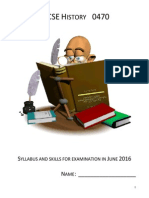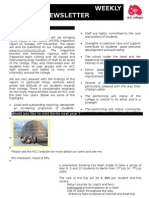100%(6)100% found this document useful (6 votes)
3K viewsKS3 History Mark Scheme
KS3 History Mark Scheme
Uploaded by
Dafydd HumphreysThe document outlines the key features and levels of performance in a history mark scheme. Level 3 involves listing facts and describing changes across periods. Level 4 adds awareness of changes within periods and understanding of reasons and results. Level 5 involves linking events and changes and starting to evaluate sources. Level 6 examines reasons for events and changes, evaluates sources critically, and organizes information. Level 7 analyzes relationships, explains interpretations, and shows some independence in reaching conclusions.
Copyright:
Attribution Non-Commercial (BY-NC)
Available Formats
Download as DOC, PDF, TXT or read online from Scribd
KS3 History Mark Scheme
KS3 History Mark Scheme
Uploaded by
Dafydd Humphreys100%(6)100% found this document useful (6 votes)
3K views1 pageThe document outlines the key features and levels of performance in a history mark scheme. Level 3 involves listing facts and describing changes across periods. Level 4 adds awareness of changes within periods and understanding of reasons and results. Level 5 involves linking events and changes and starting to evaluate sources. Level 6 examines reasons for events and changes, evaluates sources critically, and organizes information. Level 7 analyzes relationships, explains interpretations, and shows some independence in reaching conclusions.
Original Description:
Can be used across KS3 marking and assessing.
Copyright
© Attribution Non-Commercial (BY-NC)
Available Formats
DOC, PDF, TXT or read online from Scribd
Share this document
Did you find this document useful?
Is this content inappropriate?
The document outlines the key features and levels of performance in a history mark scheme. Level 3 involves listing facts and describing changes across periods. Level 4 adds awareness of changes within periods and understanding of reasons and results. Level 5 involves linking events and changes and starting to evaluate sources. Level 6 examines reasons for events and changes, evaluates sources critically, and organizes information. Level 7 analyzes relationships, explains interpretations, and shows some independence in reaching conclusions.
Copyright:
Attribution Non-Commercial (BY-NC)
Available Formats
Download as DOC, PDF, TXT or read online from Scribd
Download as doc, pdf, or txt
100%(6)100% found this document useful (6 votes)
3K views1 pageKS3 History Mark Scheme
KS3 History Mark Scheme
Uploaded by
Dafydd HumphreysThe document outlines the key features and levels of performance in a history mark scheme. Level 3 involves listing facts and describing changes across periods. Level 4 adds awareness of changes within periods and understanding of reasons and results. Level 5 involves linking events and changes and starting to evaluate sources. Level 6 examines reasons for events and changes, evaluates sources critically, and organizes information. Level 7 analyzes relationships, explains interpretations, and shows some independence in reaching conclusions.
Copyright:
Attribution Non-Commercial (BY-NC)
Available Formats
Download as DOC, PDF, TXT or read online from Scribd
Download as doc, pdf, or txt
You are on page 1of 1
KS3 History Mark Scheme
Some features of level 3
• Lists facts about events, people and changes
• Describes changes across periods, (but not within them)
• Provide some reasons/results
• Make deductions from a historical source
• Answers are relevant but not structured
Some features of level 4
• Demonstration of factual knowledge
• Awareness of changes within periods, as well as across periods
• Ability to describe events, people and changes, not just show knowledge of
them
• Understanding of reasons and results of events
• Ability to select and combine information from historical sources
• Beginnings of structured writing
Some features of level 5
• Ability to make links between events, changes and features of past societies.
• Starting to evaluate the usefulness of sources.
• Selecting and organising information to produce structured work.
Some features of level 6
• Can make links between features within and across different periods.
• They examine and explain the reasons for, and results of, events and changes.
• They identify and evaluate sources of information, which they use critically to
reach and support conclusions.
• They select, organise and deploy relevant information to produce structured
work.
• Pupils describe, and begin to analyse, why there are different historical
interpretations of events, people and changes.
Some features of level 7
• They use links to analyse relationships between features of a particular period
or society, and to analyse reasons for, and results of, events and changes.
• They explain how and why different historical interpretations have been
produced.
• They sometimes reach substantiated conclusions independently.
• Pupils show some independence in following lines of enquiry, using their
knowledge and understanding to identify, evaluate and use sources of
information critically.
• They select, organise and use relevant information to produce well-structured
narratives, descriptions and explanations, making appropriate use of dates and
terms.
You might also like
- 9699 Teacher Guide (For Examination From 2021)Document28 pages9699 Teacher Guide (For Examination From 2021)chemceptualwithfaizNo ratings yet
- 9489 Scheme of Work Paper 1 and 2 - International History (For Examination From 2021)Document36 pages9489 Scheme of Work Paper 1 and 2 - International History (For Examination From 2021)Pedro Giorgieri67% (3)
- 6th Central Pay Commission Salary CalculatorDocument15 pages6th Central Pay Commission Salary Calculatorrakhonde100% (436)
- 6th Central Pay Commission Salary CalculatorDocument15 pages6th Central Pay Commission Salary Calculatorrakhonde100% (436)
- The Future of The British MonarchyDocument8 pagesThe Future of The British MonarchyKrisztofer NagyNo ratings yet
- Cambridge A Levels History Paper 3 Scheme of WorkDocument14 pagesCambridge A Levels History Paper 3 Scheme of WorkDamian Dze Aja SuhNo ratings yet
- King's InterHigh - GCSE Subject Booklet 20232024Document55 pagesKing's InterHigh - GCSE Subject Booklet 20232024AbuzarNo ratings yet
- Self - Assessment PresentationsDocument1 pageSelf - Assessment Presentationsapi-378959333100% (1)
- SyllDocument5 pagesSyllapi-282526559No ratings yet
- Cambridge IGCSE HistoryDocument3 pagesCambridge IGCSE Historymishonew100% (1)
- Geography Year 3: Prepared By: Ms - Stephanie CrossDocument11 pagesGeography Year 3: Prepared By: Ms - Stephanie Crossstephaniecross0% (1)
- GCSE History B Spec 2012Document75 pagesGCSE History B Spec 2012jcanvinNo ratings yet
- Revision Guide 2010-11 HY116: International History Since 1890Document21 pagesRevision Guide 2010-11 HY116: International History Since 1890ewfwefwe100% (1)
- Schlieffen WarDocument15 pagesSchlieffen WarJames GleesonNo ratings yet
- Use This OneDocument36 pagesUse This Oneapi-357329019No ratings yet
- Example of History Unit Plan Using Planner 3Document9 pagesExample of History Unit Plan Using Planner 3Marrian J100% (1)
- Pearson Edexcel International GCSE (9-1) History Germany - Development of Dictatorship, 1918â 45 Student Book Å Ç Å Ç ÈDocument123 pagesPearson Edexcel International GCSE (9-1) History Germany - Development of Dictatorship, 1918â 45 Student Book Å Ç Å Ç ÈYoko LiNo ratings yet
- CieDocument24 pagesCiedhruvNo ratings yet
- Igcse 2016 History Paper 2Document4 pagesIgcse 2016 History Paper 2hdogNo ratings yet
- Gcse Int History Issue 4 For WebDocument186 pagesGcse Int History Issue 4 For Webapi-298584351No ratings yet
- Ib History Paper3Document56 pagesIb History Paper3Ryan Santosh100% (1)
- Edexcel IGCSE History P1 Sample QuestionsDocument26 pagesEdexcel IGCSE History P1 Sample QuestionsJohn Smith100% (1)
- Upper Primary English Test & GrammarDocument10 pagesUpper Primary English Test & GrammarTEY JUN HAN MoeNo ratings yet
- Support For GeographyDocument2 pagesSupport For GeographyAsif NazeerNo ratings yet
- Theme 1 - Case Study BookletDocument21 pagesTheme 1 - Case Study BookletWarlinghamGeog100% (3)
- KS3: Who Has Come To Britain, and When? Developing Questioning Through Timeline MapsDocument20 pagesKS3: Who Has Come To Britain, and When? Developing Questioning Through Timeline MapsIreland in Schools100% (4)
- IGCSE History Revision Site PPT ConclusionDocument13 pagesIGCSE History Revision Site PPT Conclusioncchan1120No ratings yet
- What Is Instructional IntelligenceDocument4 pagesWhat Is Instructional Intelligenceapi-257322149No ratings yet
- Lesson 4Document8 pagesLesson 4api-236682830No ratings yet
- Tourism GeographyDocument36 pagesTourism Geographyeghaderi1375No ratings yet
- IGCSE History World War One SampleDocument2 pagesIGCSE History World War One SampleMariam AhmedNo ratings yet
- Cambridge Igcse Depth Study A Ww1Document14 pagesCambridge Igcse Depth Study A Ww1Anonymous RltnRs1UGNo ratings yet
- History SyllabusDocument40 pagesHistory SyllabusChido Shamhu100% (1)
- Schemes of WorkDocument123 pagesSchemes of WorkAwan_123No ratings yet
- Historical ThinkingDocument30 pagesHistorical Thinkingcorbinmoore167% (3)
- Field InquiryDocument44 pagesField InquiryLiliana Caughman100% (1)
- Syllabus and HandoutDocument7 pagesSyllabus and Handoutapi-264835107100% (1)
- Edexcel GCSE History A - Schools History Project Revision Guide & Workbook SampleDocument8 pagesEdexcel GCSE History A - Schools History Project Revision Guide & Workbook SamplePearson SchoolsNo ratings yet
- Paper 1 Student Responses W MarksDocument68 pagesPaper 1 Student Responses W MarksKudzaishe MudareNo ratings yet
- 9780521189323Document23 pages9780521189323eibsource100% (2)
- Ial Revision GuideDocument25 pagesIal Revision Guidemedrica k100% (1)
- Argument Guidebook - Ebook-2Document30 pagesArgument Guidebook - Ebook-2Sahil KaundunNo ratings yet
- Geography 1esoDocument4 pagesGeography 1esomagrotasNo ratings yet
- All Tudor Exam QuestionsDocument4 pagesAll Tudor Exam QuestionsCamila CoppolecchiaNo ratings yet
- Global Citizenship GuidesDocument24 pagesGlobal Citizenship GuidesOxfamNo ratings yet
- Resource Mapping IAL HistoryDocument9 pagesResource Mapping IAL HistoryNiranjan BhuvanaratnamNo ratings yet
- GCSE GEOG REVISED PP MayJune 2010 Higher Tier Unit 2 Living in Our World 7768Document24 pagesGCSE GEOG REVISED PP MayJune 2010 Higher Tier Unit 2 Living in Our World 7768Aimee DohertyNo ratings yet
- Example Candidate Responses Paper 4 For Examination From 2020Document25 pagesExample Candidate Responses Paper 4 For Examination From 2020harrythalaivan100% (1)
- TEaching English Through HistoryDocument24 pagesTEaching English Through HistoryDaniel Cano RubioNo ratings yet
- Edexcel KS3 History Scheme of WorkDocument22 pagesEdexcel KS3 History Scheme of Workkfhkdl100% (1)
- Model United Nations PresentationDocument41 pagesModel United Nations PresentationJayant MalhotraNo ratings yet
- IGCSE GP IntroDocument33 pagesIGCSE GP IntroeburkeNo ratings yet
- IGCSE Geography Revision BookletDocument87 pagesIGCSE Geography Revision Bookletyusuf.liya2008100% (1)
- Hass Unit PlanDocument11 pagesHass Unit PlanJessicaNo ratings yet
- GCSE HistoryDocument12 pagesGCSE HistoryPaola Estefania100% (1)
- Chapter1 - Case Study1 - JapanDocument22 pagesChapter1 - Case Study1 - JapanHenrique Abreu100% (1)
- 6 Historical Thinking ConceptsDocument6 pages6 Historical Thinking ConceptsMichael WrightNo ratings yet
- Oxford Insight History Australian Curriculum For NSW Year 8 Scope and SequenceDocument8 pagesOxford Insight History Australian Curriculum For NSW Year 8 Scope and SequenceMarinaNo ratings yet
- Culture Is Like An IcebergDocument2 pagesCulture Is Like An IcebergDoina GheorghiuNo ratings yet
- sshejsjDocument56 pagessshejsjAron Jose Quisel ArbasNo ratings yet
- Characteristics Strengths, Etc of QualiDocument50 pagesCharacteristics Strengths, Etc of QualiLarry ErbiteNo ratings yet
- Newsletter 21novDocument4 pagesNewsletter 21novDafydd Humphreys100% (1)
- HCC NewsletterDocument2 pagesHCC NewsletterDafydd HumphreysNo ratings yet
- Newsletter 21novDocument4 pagesNewsletter 21novDafydd Humphreys100% (1)
- Francis Bacon - Research ProjectDocument1 pageFrancis Bacon - Research ProjectDafydd HumphreysNo ratings yet
- PE Health and Fitness Brief and Assessment SheetDocument2 pagesPE Health and Fitness Brief and Assessment SheetDafydd Humphreys100% (1)
- Lesson 1 How To Use PhotoshopDocument36 pagesLesson 1 How To Use PhotoshopDafydd Humphreys100% (3)
- Year 8 Assessment Guide 07Document1 pageYear 8 Assessment Guide 07Dafydd HumphreysNo ratings yet
- Lesson 4 - Fauvism With PastelsDocument15 pagesLesson 4 - Fauvism With PastelsDafydd Humphreys100% (4)
- NoteDocument1 pageNoteDafydd HumphreysNo ratings yet
- Speaking and Listening MediaDocument1 pageSpeaking and Listening MediaDafydd HumphreysNo ratings yet
- ICT Brief and Assessment Y8 Short Film PitchDocument2 pagesICT Brief and Assessment Y8 Short Film PitchDafydd HumphreysNo ratings yet
- How Do Artists' Names Link To Their Image?Document13 pagesHow Do Artists' Names Link To Their Image?Dafydd HumphreysNo ratings yet
- Re-Drafting Descriptive WritingDocument1 pageRe-Drafting Descriptive WritingDafydd Humphreys100% (2)
- Planning A Music Review: Worksheet 8Document1 pagePlanning A Music Review: Worksheet 8Dafydd HumphreysNo ratings yet
- 1 A: An Ordered Recurrent Alternation of Strong and Weak ElementsDocument6 pages1 A: An Ordered Recurrent Alternation of Strong and Weak ElementsDafydd HumphreysNo ratings yet
- EvaluationDocument2 pagesEvaluationDafydd HumphreysNo ratings yet


